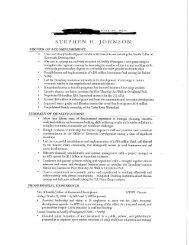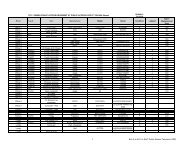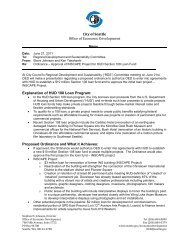2013 Water System Plan, Volume II - Seattle City Clerk's Office - City ...
2013 Water System Plan, Volume II - Seattle City Clerk's Office - City ...
2013 Water System Plan, Volume II - Seattle City Clerk's Office - City ...
You also want an ePaper? Increase the reach of your titles
YUMPU automatically turns print PDFs into web optimized ePapers that Google loves.
5.6.3.1 Minimum Pipe Size<br />
The standard water distribution main size is:<br />
8-inch-diameter pipe for residential areas<br />
12-inch diameter pipe for industrial and commercial areas<br />
Dead-end distribution mains typically include fire hydrants and must be at least 8-inches in<br />
diameter. Typically, feeder mains are 16- to 30-inch diameter pipes. Some SPU feeder mains are<br />
more than 30 inches in diameter. Pipes more than 30 inches in diameter must not have service<br />
connections.<br />
5.6.3.2 Material Types<br />
All new or replaced water pipe in the <strong>City</strong> of <strong>Seattle</strong> must meet the standard material types<br />
shown in Table 5-4.<br />
Table 5-4<br />
Standard Materials for SPU Distribution and Feeder Mains<br />
Structure<br />
Pipe<br />
Bends and Fittings<br />
Joints<br />
Casing<br />
Material<br />
2-inch diameter pipe must be Type K copper (when allowed by SPU).<br />
4-inch diameter and larger pipe must be ductile iron pipe, class 52 or thicker, cement<br />
lined-double thickness.<br />
Feeder mains larger than 20-inch diameter must be ductile iron or steel.<br />
Typically, bends and fittings must be the same material as the pipeline.<br />
Fittings for 2-inch copper soft coil must be brass, either flared or compression.<br />
Joints for ductile iron water mains must be restrained joint, slip joint, or mechanical<br />
joint.<br />
Joints on steel casing pipe must be welded and conform to AWS D1.1 Structural<br />
Welding Code, Section 3, Workmanship.<br />
Whether installed above- or below-grade, casing pipe must be smooth steel, with the<br />
diameter and wall thickness specified in the drawings.<br />
All joints must be welded by qualified operators. Steel casing pipe is discussed in Std<br />
Spec 9-30.2.<br />
Casing seals and spacers must be per Std Spec 9-30(15).<br />
If specified in the contract, the space between the carrier pipe and casing pipe must be<br />
filled with sand, grout, or some other material.<br />
Non-standard mains less than 8 inches in diameter and approved by SPU, must be ductile iron,<br />
except for 2-inch pipe, which must be Type K copper.<br />
5.6.3.3 Pipe Cover<br />
Depths of cover for water mains are shown on Standard <strong>Plan</strong> No. 030. The depths vary<br />
depending on size of pipe. Mains larger than 12 inches in diameter typically use butterfly valves.<br />
Butterfly valves require less cover due to their shape and allow large mains to be buried at<br />
shallower depths. Generally, SPU attempts to bury the pipes as shallow as feasible for ease of<br />
installation and maintenance, but no less than 35 inches deep except in special cases as directed<br />
by SPU. The depth to the pipe invert should be kept to less than 6 feet to reduce the need and<br />
cost for excavation and shoring.<br />
5-18 SPU Design Standards and Guidelines
















